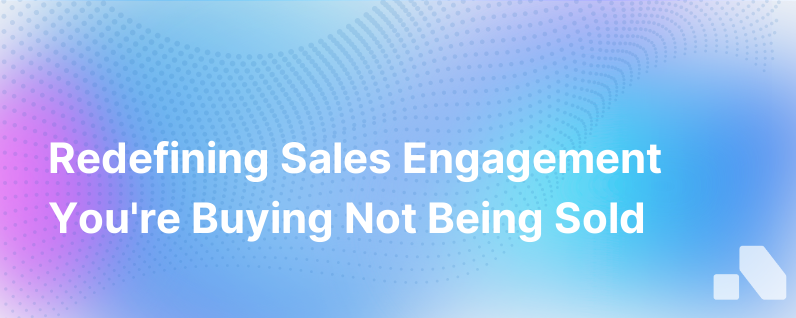
In the complex maze of B2B sales strategies, there is a subtle yet profound shift where traditional approaches no longer cut it. We are inching away from the cliche of aggressive selling to embrace a more nuanced, enlightened customer-centric approach. This is often condensed into a simple mantra: "I'm not selling, you're buying."
The phrase encapsulates a fundamental change in perspective — from pushing products to facilitating purchases. It's turning the stereotypical aggressive salesperson into an advisory guide who assists at every step of the buyer's journey.
But what does this mean in practical terms? How can your sales team make this shift in approach and why does it matter? Here is a detailed exploration.
Understanding The Buyer's Journey It's crucial for sales teams to fully understand the modern buyer's journey, as it is not a linear process but rather a complex web of information-seeking and decision-making. Today’s buyers are well-informed, sophisticated consumers of content. They've typically researched solutions, compared options, and formed opinions before they even engage with a salesperson.
In this environment, the salesperson’s role is to become a part of the conversation as early as possible — not to dominate it, but to nurture and guide it. Here’s how:
- Provide Value Upfront: Offer educational content, industry insights, and case studies without any expectation of immediate gain.
- Be a Trusted Advisor: Position yourself as an expert who can address pain points and help buyers navigate choices.
- Understand Needs: Develop deep empathy for buyer challenges and preferences and tailor interactions to match.
Personalization and Relevance Personalization is key to resonating with buyers. Crafting unique experiences based on a deep understanding of a prospect's specific needs not only captivates attention but also builds trust. Data and AI tools today can provide sales teams with rich insights into individual buyer preferences and behaviors, enabling sales approaches that feel less like selling and more like helping.
Flexibility and Patience Sales cycles in the B2B world can be long and unpredictable. Patience is more than a virtue here; it's a strategic necessity. Instead of pressuring prospects to make quick decisions, the focus should be on maintaining flexibility and understanding the dynamic nature of business procurement.
Educational Selling This technique revolves around teaching the customer about their pain points, industry best practices, and solutions. When done correctly, it positions your product or service in the context of the customer's needs without a hard sell. A salesperson acting as an educator underlines the idea of 'you're buying, I'm not selling'.
Consultative Selling Taking educational selling a step further, consultative selling is about deep engagement with a customer's problem space. This involves asking insightful questions, actively listening, and providing customized solutions. For the buyer, the sales interaction becomes a discovery process, with the salesperson acting as a consultant rather than a salesperson.
Building Partnerships The foundation of the 'I'm not selling, you're buying' philosophy is a partnership approach. Fostering collaboration, alignment, and a mutual sense of value can enhance customer loyalty and long-term business impact. By becoming a partner, rather than a vendor, you embed your solutions within their business strategy.
Measurement and Improvement A data-driven understanding of the customer's purchase process and your own sales effectiveness is crucial for continual improvement. Tools such as Customer Relationship Management (CRM) systems and platforms like Aomni can assist in quantifying and analyzing this data, providing a compass for strategic customer interactions.
The Power of Narrative Humans, by nature, are drawn to storytelling. Craft a compelling brand narrative that isn't just about the product but about the vision, the journey, and how the customer is an integral part of this story. Wrap your product values in a narrative that speaks to the customer's needs.
Content Is King An arsenal of high-quality content is indispensable for this approach to sales. From blog posts and whitepapers to webinars and podcasts, content draws prospects toward your brand and its expertise rather than pushing a sale upon them.
Customer Advocacy Leverage the voices of satisfied customers with a robust advocacy program. Testimonials, case studies, and customer references can be powerful tools in validating your approach and offering.
Conclusion The shift from aggressive selling to facilitative buying is not a superficial one. It's rooted in respect for the customer's intelligence, autonomy, and capacity to make well-informed decisions.
In a landscape where buyers are bombarded with aggressive sales pitches, a genuine approach that emphasizes their purchase rather than your sale not only stands out but is preferred. They are not mere leads; they are partners embarking on an important decision-making process in which you are a trusted guide.
This enlightened approach aligns perfectly with the mission of Aomni, an AI-driven platform designed to underpin sales strategies that prioritize intelligent account research, competitive insights, and tailored sales content. By streamlining the collection and processing of this crucial data, Aomni enables sales teams to adopt a buyer-centric stance effortlessly. With it, you can ensure that every engagement with a prospect is rich with value, positioning you not as someone who's selling, but as the essential partner in their own buying decision.